|
|
|
Greetings in the month known as "Shiwasu,"
The busy-ness of this time of the year is reflected in that word, the traditional name for the final month of the year. It’s meaning implies that things are so hectic that even the teacher (presumably of a trade, art, or practice) is running around, as there is so much to do that his or her minions or protégés alone cannot handle it. And so true it seems.
While we have the whole Shiwasu season yet to go before this year closes, it has been a heavy one, to say the least. And it has been a particularly heavy year in Japan. But as the winter begins to chill the weather down, everything else seems to be warming up at least a little. Sake brewing, sake sales, sake love. And so much more outside of the sake world and Japan as well seem poised to begin moving, albeit slowly, toward resolution.
Let us hope and pray that it continues in that direction for the rest of Shiwasu and through 2012.
Happy Holidays to all readers.
Warm regards, and please enjoy the newsletter,
John Gauntner
 
|
Sake Rice in Downtown Tokyo
Hakutsuru Nishiki on Ginza Rooftop
Hakutsuru, the largest sake brewery in the Universe, is headquartered
in the Nada ward of Kobe, in Hyogo Prefecture. But they have an office in Tokyo as well, in Ginza no less, not a stone’s throw from the currently-being-rebuild Kabukiza.
There they have a business office for 80 employees or so, and a (fully licensed!) miniature sake brewery for making table-top batches for experiments and consumer-oriented activities, as well as a cool event space too. On the roof of this building, in downtown Tokyo, they grow a small amount (about 60kg, or one “hyou” – kinda sorta like a traditional bushel) of proprietary sake rice, a strain called Hakutsuru Nishiki. Much, much more Hakutsuru Nishiki is grown in Hyogo, under superior conditions.
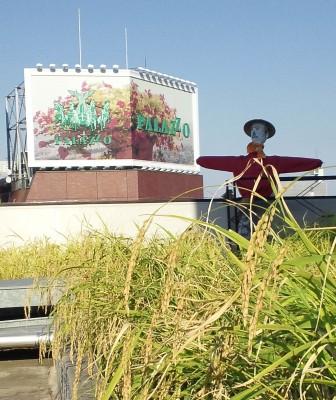 |
|
One of the things that made Nada sake the industry standard 250 years ago was the proximity to good sake rice. Back then, Yamada Nishiki did not exist; that came about in 1923, after which the Nada brewrs heartily embraced it. So tightly, in fact, that no one else could get any. But as technology developed, they were able to “get away with” using cheaper rice, and some of that Yamada Nishiki became available to other brewers. But that is a different story…
Yamada Nishiki was created by crossing two other rice types: Yamadaho and Tankan Wataribune. Many folks say this Tankan Wataribune is, or at least was, actually Omachi rice, grown in the Kanto (near Tokyo) area rather than the Kansai (Kyoto-Osaka-Kobe) area. Somehow the name “got” changed to Wataribune. Also, the word
Tankan means short-stalk. So what they did was take this long Omachi rice, and select seeds from the shortest of the lot to grow again next year. Kind of Darwinism in reverse. But I digress again.
Why would they do that? Because if rice is too tall, it falls over before it is ready to be harvested, and then it must be harvested or it will germinate and no longer be useable in sake brewing. Last digression; I promise.
In any event, if we look at Hakutsuru’s promotional materials, we see that their proprietary rice, Hakutsuru Nishiki, has the same parents. In other words, Hakutsuru Nishiki is also a cross between Yamadaho and Tankan Wataribune. They are siblings, so to speak.
At that point, I just assumed, OK, it is a promotional marketing thing. “It’s the same rice, let us give it a different name, fudge things so that we can get it registered as a separate rice, it will be ours-all-ours, and then we get on with our marketing.” Not that anything is wrong with that approach…
But I was wrong. Oh, how wrong I was. And I realized that the moment I saw that rice growing on the Ginza rooftop. One glance was all it took.
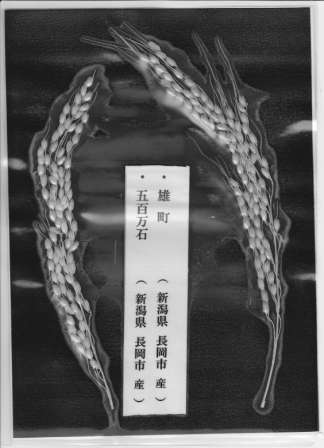 |
|
How could I be so sure? Because the rooftop rice - due to be harvested in a couple of days - had a noge near the grains. A noge (pronounced noh-geh) is a strand, a stiff hair-like part of the plant that sticks out above and beyond the seeds. I tried to get a photo of it, but that proved hard in the blowing autumn Tokyo-rooftop wind. Here is the noge from a sample of Omachi, on the right, versus a sample of no noge Gohyakumangoku on the left.
Usually, only pure strains have noge. Omachi does; Yamada Nishiki does not. It is said that the function of noge was to deter birds from eating the seeds by making it difficult to get near the grains without poking one’s bird-self in the bird’s eye, so to speak.
And this is where one glance at the rooftop rice told me I was wrong in my assumptions. As I said: Yamada Nishiki does not have a noge. But Hakutsuru Nishiki does. That very clearly makes it a different rice. I am not sure why this surprised me so much; any two parents of anything can have two children that are totally different. Why should sake rice be any different? But I admit, I was surprised.
So clearly, Hakutsuru Nishiki is indeed a different rice than Yamada Nishiki, and both come from the same good parents.
A bit more research revealed a bit more information. Yamadaho fell out of favor, it seems, after spawning its protégé, and was revived in 1991 and is used in brewing a couple of sake here and there. Hakutsuru Nishiki was created in 2004, and compared to its more illustrious sibling, it is shorter (easier to grow) has the same low protein content (good for cleaner flavors) and even a bigger shimpaku (the white starch packet in the center of the grains).
While very little is as of yet grown, Hakutsuru does make one small-production junmai daiginjo using it. Hard to get outside of Kobe, and certainly outside of Japan, it is called “Toji no Kyujitsu,” or “the toji’s day off.” As if something like that existed…but I digress once again.
|
|
Suisen Back Brewing - against all odds
And other Tohoku news
In the March 11 earthquake and tsunami, literally hundreds of breweries were damaged in the northeastern half of Japan. No one knew what would happen; who would recover, and who would not.
But check this fact out: not one single brewery threw in the towel. Not one kura out there quit, gave up, or decided they could not continue. Every single damaged, crushed, shaken or flooded sake brewery somehow, by hook or by crook, through sheer determination and will, has begun to brew sake again this year. How they will fare is of course not known. But the incredible courage to do that is, very sincerely, incredibly inspiring to me.
Perhaps the most amazing example is Suisen, the brewery that was pummeled and destroyed by the tsunami on March 11 on national television.
After the tsunami, in which Suisen lost a handful of employees, the brewery owner, Mr. Kohno, released everyone pending a new start. He made that start by borrowing a brewery owned by Iwate Meijo also of Iwate Prefecture, their Tamanokawa brewery (they have more than one and this one was not currently in use) and got a new license on July 1, after which he hired his staff back. They do intend to return to Rikuzen Takada, where they originally were located, someday.
The began brewing September 12 and wanted to ship product on October 1, but due to shortages and a lack of familiarity on the part of the brewing staff with the equipment, things will be delayed a couple of weeks.
They are starting with a sparkling genshu Yukikko and will release next month a
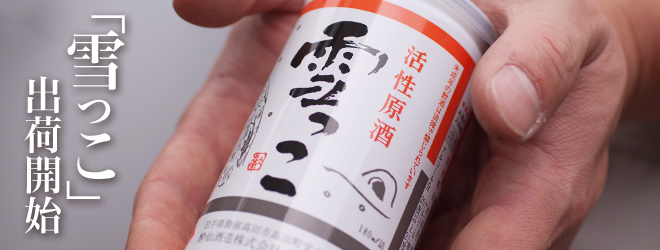 |
|
new year’s sake called Hassou. “We chose those two to start with as they were the seasonal products we shipped this time every year when we were in the original brewery, with hopes that it will instill the locals with courage.”
A program shown on NHK television last week showed their plight, their path, and the culmination of their efforts in the shipping of Yukikko on October 17.
The spirit of cooperation displayed is amazing to me. A competitor loaned this company facilities so they could survive and continue to compete. The significance was not lost on Mr. Kohno, who added with obvious gratitude, “receiving support from a competitor is powerfully moving to us.” They plan to continue using this brewery until they can rebuild one in Rikuzen Takada.
Such cooperation was also shown back in Kobe in the 1997 earthquake, where brewers in Nada lent their facilities to others that had lost theirs. Inspiring. Amazing.
In other good news, as of this fall, sake shipments were up 3% over last year. While this may not seem much, remember that things have been in decline almost every year for the past two decades, and in fact, sake shipments today are down about two thirds from their peak in 1973. In that light, 3% is huge, and many including myself see this as the turning point. Surely the road ahead is still fraught with hardship. But one step at a time.
****
Should you hear talk of concern about the effects of radiation from the nuclear accident in March on sake, here is a bit of recent news.
All rice has been checked multiple times since it was planted through to harvest. While some rice was found to have high levels of cesium, that small amount was from Fukushima near the Dai-ichi plant, and was not sake rice, but eating rice. No sake rice turned up any high levels of cesium.
On top of that the government has set up a thorough testing system of all alcoholic beverages (among other things) made within 150 km of Dai-chi, and 20% to 40% of products outside of that range, covering all of Japan. The first round of checking, which included 235 products, showed that all of them were safe by a longshot.
More information will be posted on my blog, as it becomes available, at
http://sake-world.com/wordpress/
Would you like to know when new stories are posted? Please follow me on Twitter.
|
| Sake Basics: Ordering Hot Sake
And sounding cool about it
How do you order hot sake, in Japanese? The short answer? Ask for “
O-kan.” That is a polite-ish way to request hot sake in general.
Should the topic be under discussion, when honorifics might not be needed, often it is referred to as
kanzake, especially when there is a need to differentiate it from hiya, or cold sake. But o-kan is likely better when ordering it.
Of course, if you want to specify your temperature range (assuming you can do that at the establishment in which you find yourself),
atsukan refers to hot-to-very-hot sake. If you prefer it less hot so as to allow subtle flavors to reveal themselves, then
nuru-kan, or tepidly warmed sake is the term you need.
Bear in mind, most ginjo, or premium sake, is enjoyed slightly chilled. But there are exceptions, and we don’t need to go premium all the time. Besides - 'tis the season, and will be for another couple of months.
|
|
Did You Know?
Sugidama = Sakabayashi
One cannot spend much time around sake, either in Japan or elsewhere, without coming across the iconic sight of the globes of green-then-brown cedar needles. You have likely seen them hanging in front of sake shops, certainly sake breweries, and in pictures in books, magazines, and the interest. What are those puppies? What is their significance?
While more can be read here, in short they are known as sugidama, or alternatively if less commonly sakabayashi. They have evolved into symbols of the sake world, and are found hanging outside and often inside of any sake brewery. Traditionally, they are made in-house and hung out when the first sake of the season is pressed. The green cryptomeria needles eventually turn brown, which takes about as long as it does for the sake to mature, so that when they complete that color change, the sake is deemed ready to drink.
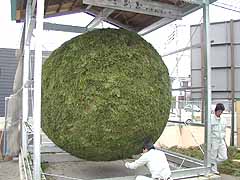 |
|
Most sugidama are the size of basketballs. But one brewery in Fukuoka, the maker of Kitaya sake, takes the time and effort to make what it calls “the biggest sugidama in the world.”
See how they make it here. The link at the bottom of each page will take you to the next page of photos; you can see how it is constructed. (Just mentally minimize the process to imagine how a normal sugidama would be made!)
So, the next time someone asks you, "Did You Know?" you can answer, "Why, yes, I did know."
|
 Announcements and Events Announcements and Events
Sake Professional Course in Japan
January 23 ~ 28, 2012
From January 23 to 28, 2012, I will hold the 9th annual Sake Professional Course in Japan. This is it, folks, the most intensive, immersing, comprehensive sake educational prog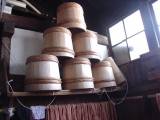 ram in existence. Three days of classroom lectures and tastings (capped off each night with a scrumptious sake dinner at one of Tokyo's best sake pubs) are followed by two days of brewery visits to lock it all in. It will conclude with certification testing for the Certified Sake Specialist, recognized by the Sake Education Council. ram in existence. Three days of classroom lectures and tastings (capped off each night with a scrumptious sake dinner at one of Tokyo's best sake pubs) are followed by two days of brewery visits to lock it all in. It will conclude with certification testing for the Certified Sake Specialist, recognized by the Sake Education Council.
SPC Japan is a bit more exclusive as only 20 people can participate, and currently 18 of those spots are filled. What this means is that the (sake) glass is either 90% full, or 90% empty, depending in your point of view. The cost for the course, including all five days and evening meals as well, is 180,000 yen. For more information about the daily schedule and to read a handful of testimonials, click here . Feel free to contact me directly at sakeguy@gol.com with any questions about the course, or to make a reservation.
Sake Tours, 2012 ~ Akita and San-in
Sake Tourism is alive and well! Check out this year's Sake Tours
for sake-heavy tourism of Japan. Not nearly as intense as the Sake Professional Courses, and sake is not the only thing you will experience on these special tours! But certainly, they are "sake heavy."
From the website:
Please join us for a very special journey through the regional brewing and culinary traditions of Japan. Tour destinations are filled with moments you cannot experience otherwise. In 2012, we will return to San-in, the land of myth, and to the snow country of Akita for special breweries and onsen.
Meet and speak directly with artisans to appreciate their history, philosophy, and the art of brewing. Learn from the world's best sake educator, John Gauntner, and share the passion of brewers for their craft. Then, wind down at onsen to relax, and simply have fun!
Learn more and register now at the Sake Tours Website.
Sake Education Council Website
Please take a moment to check out the website for the Sake Education Council, the organization behind the Certified Sake Professional and Advanced Sake Professional certifications. We plan to grow steadily, strongly and continually, and we will need the support of all those that love sake to do so. Follow us through the "usual suspects" of social media.
Sake Homebrewer's Online Store
Please be sure to check out Homebrewsake.com for supplies, information and a forum, including lots of supporting information on everything from recipes to history. I have been meaning to mention this site and the gentleman behind it, Will Auld, but have repeatedly forgotten in past newsletters. The site is replete with instruction, augmented with videos, schedules, and more. If you are even remotely interested check this site out right away.
Don't forget the archives!
Older editions of this newsletter are archived here.
Really old editions are archived here.
|
 Sake Education Central Sake Education CentralSake Dictionary App for the iPhone, iPod and iPad
"For 99 cents, this app ROCKS!!"
-a satisfied customer
There you are, perusing a menu, or standing in front of a shelf of great sake, or perhaps reading a sake newsletter… and up pops one of those hairy, pesky sake terms in Japanese. You know you have heard it many times, but dammit, you just cannot remember what it means now…
No problem! Just whip out your iPhone or iPod and fire up your trusty old version of
The Sake Dictionary. In a matter of seconds, you’ll be amongst the cognoscenti once again. But… if only you could pronounce it properly. Now that would really rock!
Done! Just tap on the term and you will hear a clear example of how to pronounce the term in Japanese. Repeat it a couple of times and the term is yours for eternity, to toss about and impress your mates.
What’s more, it’s
less!
Less than what it cost before, much less. Like less than one-seventh less. For a limited time only, the audio-enhanced version of The Sake Dictionary iPhone app is available for a mere $0.99.
|
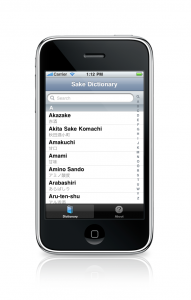 |
|
|
The Sake Dictionary is a concise little package of all the terms you might ever come across when dealing with sake. Almost 200 of them - including sake grades, rice variety names, seasonal sake terms, special varieties, rare types, post-brewing processing words and the myriad terms used in sake production - many of which are not even familiar to the average Japanese person on the street - are listed up here with concise, useful and clear definitions and the written Japanese version as well. And now, with the new audio component, you can listen and learn just how to pronounce those terms properly.
Start to toss around Japanese sake terms like you were raised knowing them! Gain a level of familiarity hitherto unimaginable! Avoid frustrating paralysis when faced with a sake-related purchase!
Get your copy of The Sake Dictionary now and never be confused by sake terms - or how to pronounce them - again.
Get it here: http://itunes.com/apps/sakedictionary
(Note if you have already purchased it, this upgrade to the audio version is free. Just go to iTunes and get it!)
|
Stay Subscribed!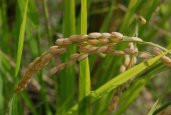
Are you not getting this newsletter? I realize that is like asking that "those not present please raise your hand," but for future reference, should you spontaneously stop receiving this newsletter, please go here and sign up again. Should that not work, please go to www.sake-world.com.
Email newsletter services are very careful not to be considered spam enablers, but the problem is that often very valid email addresses come back bounced as invalid. It is an unavoidable problem. So if you or someone you know is not getting this, or stop(s) receiving it inexplicably, please do take a moment to double check that you are still subscribed.
Sincere apologies for the hassle, mixed with gratitude for reading this newsletter. |
I hope you have found the above information helpful and entertaining. For more information about all things sake, please check out www.sake-world.com. Until next month, warm regards, and enjoy your sake. 
Questions and comments should be directed to John Gauntner, at this email address.
All material Copyright, John Gauntner & Sake World Inc.
Regards,
John Gauntner
Sake World, Inc
 . . 
|
|
